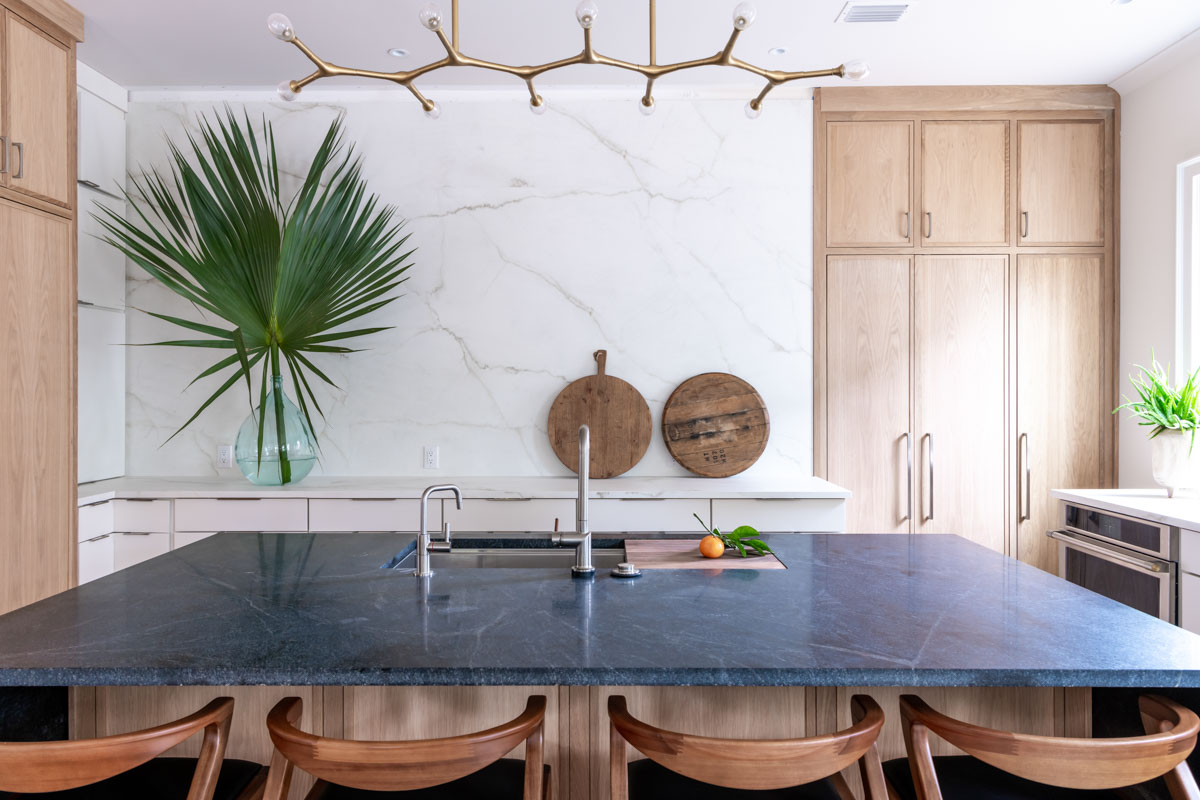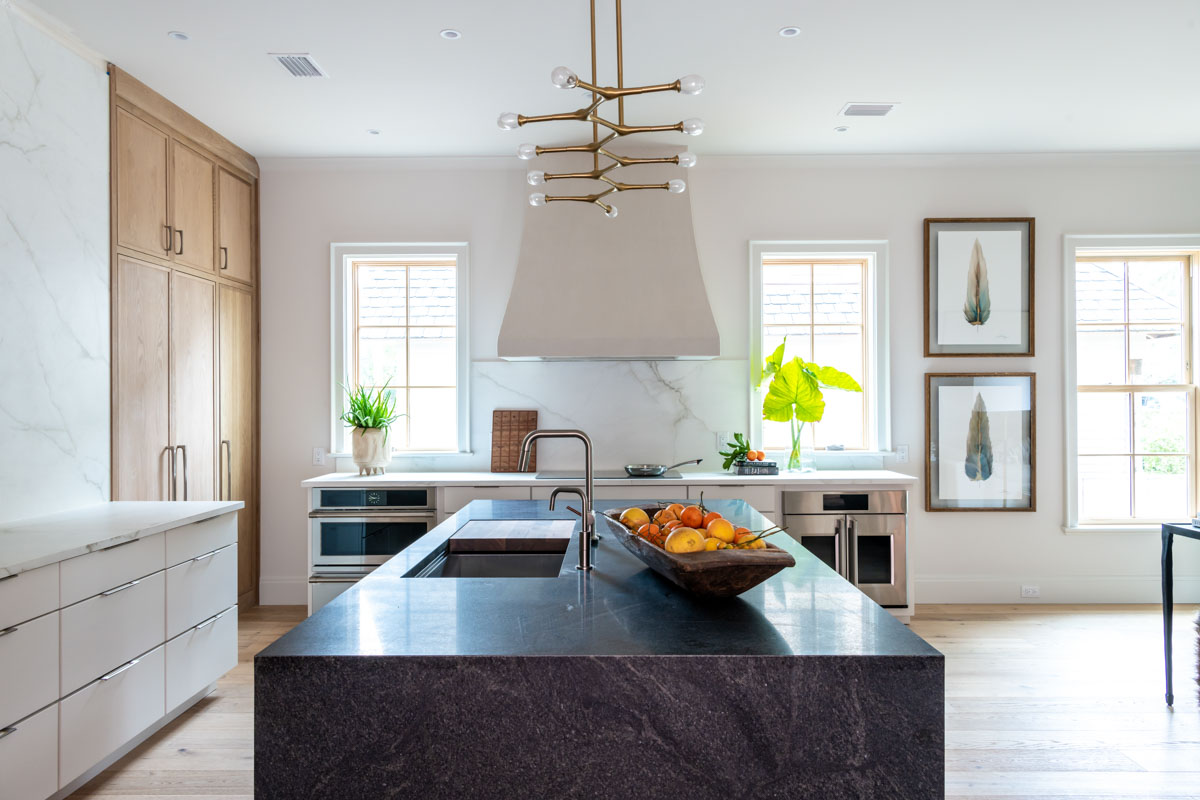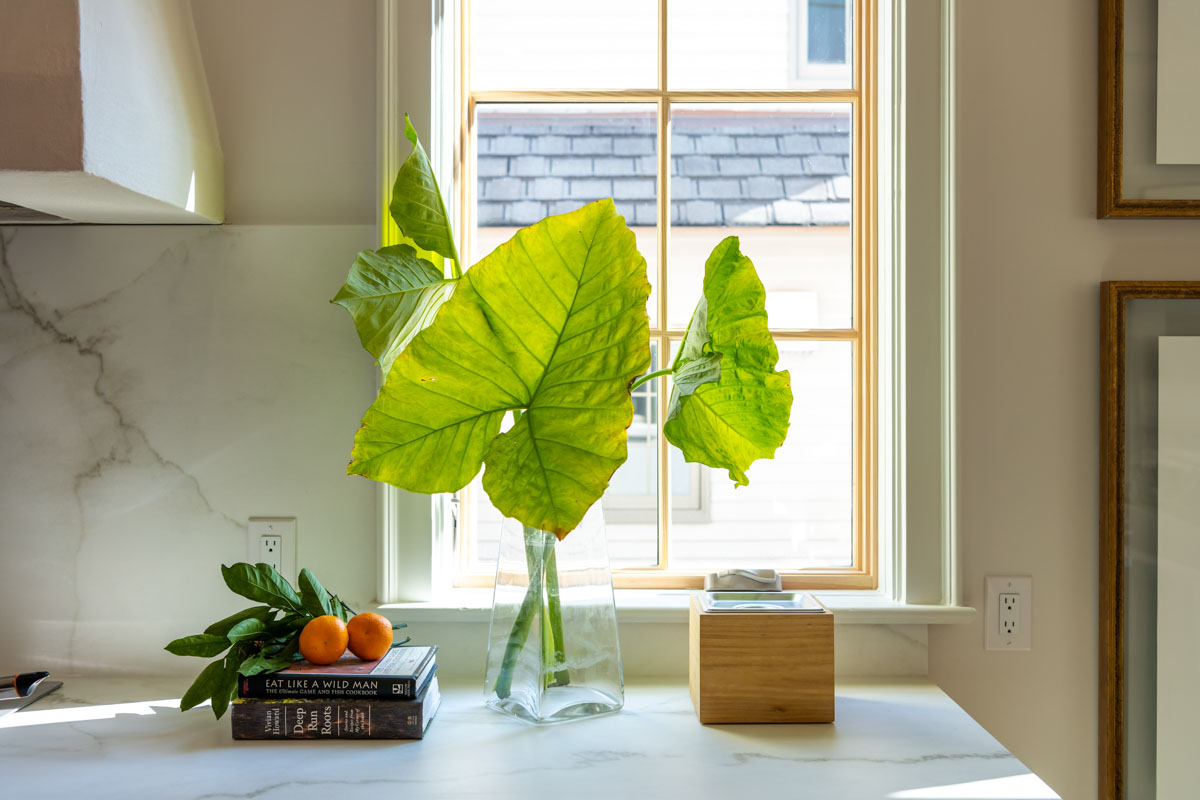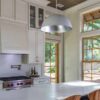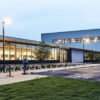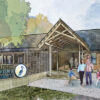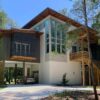Kitchen

Sustainable Design Strategies
Planning and Design
![]() In many ways here on the gulf coast, the kitchen island has replaced the hearth as the heart of the home. The Inspiration Home kitchen was designed as a gathering place, where people can come together to prepare and share food and enjoy each other’s company. The kitchen was planned to make it easy to prepare and store local foods with a generous pantry, freezer, and prep sink.
In many ways here on the gulf coast, the kitchen island has replaced the hearth as the heart of the home. The Inspiration Home kitchen was designed as a gathering place, where people can come together to prepare and share food and enjoy each other’s company. The kitchen was planned to make it easy to prepare and store local foods with a generous pantry, freezer, and prep sink.
Kitchens are also where most of the waste in a home is generated, so it is important to provide easily accessible collection points for each waste stream. The Inspiration home kitchen is designed with a two compartment pull out bin for the largest waste streams: trash and plastic recycling, with additional recycling storage in the pantry for aluminum, glass, paper, and cardboard. A beautifully crafted compost collection bin makes it easy to collect food scraps for recycling in the garden.
Kitchens are also responsible for a significant amount of a home’s energy use. The Energy Star certified appliances in the Inspiration Home kitchen conserve both energy and water. Purchasing Energy Star appliances is a simple act that makes a big difference. To make an even bigger difference, start with the “most efficient” list published by Energy Star each year, highlighting top performing products. If every appliance purchased in the United States this year were ENERGY STAR certified, we would prevent greenhouse gas emissions equal to those from 215,000 cars—and save $360 million in annual energy costs.
Last, The public health threat posed by COVID-19 has generated calls for the use of added antimicrobials in the built environment. Anti-microbials serve a valuable role as preservatives in some products, but there is no evidence that using building products with antimicrobial ingredients reduces the number of people infected with specific pathogens. There are known adverse health effects from anti-microbials, and there is also evidence that commonly used antimicrobials can cause resistance to the antibiotics that we depend on to fight disease. For these reasons, we intentionally did not include any building products with antimicrobial ingredients in the Inspiration Home. Instead, we design to promote human health with biophilic design, and protect human and ecological health with clean materials that keep harmful chemicals out of supply chains and the interior environment.
“Color Tunable” Lighting
 Our bodies evolved in sunlight. Daylight changes in color throughout the day, from warm morning light, to cooler and brighter mid day light, back to warm evening light. Exposure to those shifting color temperatures defines our circadian rhythms, which in turn regulate our sleep cycles, our weight, and our health. We see technology adapting to recognize this, with phones that change to a warmer screen color in the evening to help prepare people for sleep.
Our bodies evolved in sunlight. Daylight changes in color throughout the day, from warm morning light, to cooler and brighter mid day light, back to warm evening light. Exposure to those shifting color temperatures defines our circadian rhythms, which in turn regulate our sleep cycles, our weight, and our health. We see technology adapting to recognize this, with phones that change to a warmer screen color in the evening to help prepare people for sleep.
Nora Lighting’s 2” Iolite recessed LED luminaires are equipped with “comfort dim” technology, so that it is “color tunable” from a bright sunny 3100K, to a dimmed glow at 2,000K, which is more like candlelight. This allows the interior lighting to go through the same color shifts as the light outdoors, supporting healthy circadian function and healthy sleep.
The lights also have a color rendering index of 90+ which means they will not distort your perception of color. 90% of all lighting is required to be efficient for Zero Energy Ready Certification. 100% of the lighting in this home uses super efficient LED light sources. Efficient LED Lighting reduces energy use and heat generation associated with lighting. LED’s also have an extremely long life, approximately 50 times longer than a typical incandescent, 20-25 times longer than a typical halogen, and 8-10 times longer than a typical CFL. Depending on how many hours a day the lights are used, a homeowner may only have to change an LED every 11-18 years.
Island Chandelier
![]()
Science meets structure in the Vanderpool chandelier of antique brass with clear seedy glass. The patina of the materials and the form, evoking twigs, coral or molecular geometry are biophilic design elements. Efficient LED lighting conserves energy.
Cabinets
![]() The plywood and composite wood used in cabinets can contain formaldehyde, a toxic substance associated with certain cancers. Indoor air Plus Certification requires cabinets to meet strict requirements for formaldehyde and other toxic substances. The unpainted kitchen cabinets are made of white oak and award winning “purebond” plywood that replaces formaldehyde adhesives with soy based adhesives. They are finished with a low emitting wax that highlights the character of the natural wood. Painted cabinets are also certified low emitting, and shop finished in a controlled environment, so that the paint does not off gas chemicals inside the home. Local manufacture in Fairhope and Ashland Alabama reduces the emissions and carbon impact related to transporting the cabinets to the job site.
The plywood and composite wood used in cabinets can contain formaldehyde, a toxic substance associated with certain cancers. Indoor air Plus Certification requires cabinets to meet strict requirements for formaldehyde and other toxic substances. The unpainted kitchen cabinets are made of white oak and award winning “purebond” plywood that replaces formaldehyde adhesives with soy based adhesives. They are finished with a low emitting wax that highlights the character of the natural wood. Painted cabinets are also certified low emitting, and shop finished in a controlled environment, so that the paint does not off gas chemicals inside the home. Local manufacture in Fairhope and Ashland Alabama reduces the emissions and carbon impact related to transporting the cabinets to the job site.
Porcelain Countertop
![]() The porcelain countertops use natural textures and forms to reinforce the biophilic interior environment. Crossville tile and porcelain slabs are made in Crossville TN, less than 500 miles from Fairhope, and between 95%-95% of the materials used in these products are sourced from within 500 miles of the factory. Using local and regional materials reduces the carbon impact and emissions associated with the transporting of raw and finished materials over long distances.
The porcelain countertops use natural textures and forms to reinforce the biophilic interior environment. Crossville tile and porcelain slabs are made in Crossville TN, less than 500 miles from Fairhope, and between 95%-95% of the materials used in these products are sourced from within 500 miles of the factory. Using local and regional materials reduces the carbon impact and emissions associated with the transporting of raw and finished materials over long distances.
Crossville is a leader in sustainable manufacturing processes. They reuse more than 99.98 percent of water used in manufacturing. The small amount that is not reused is returned clean to the environment. Through a certified recycling process, they recycle approximately 12 million pounds of material that previously went to landfills. Crossville remains the only tile manufacturer with a Tile Take-BackTM Program, allowing previously installed tile from any manufacturer to be returned to Crossville for recycling. Crossville works with TOTO USA, the world’s largest plumbing products manufacturer, to recycle pre-consumer waste. Crossville has developed a proprietary system of processing TOTO’s sanitary ware waste back into powder used in manufacturing new tile.
In March 2011, Crossville became a net consumer of waste, meaning they recycle more waste into new products. This recycling conserves resources; the volume of finished goods Crossville ships now exceeds the amount of raw materials it extracts from the earth for use in manufacturing.
Crossville tile and porcelain slabs are clean materials. The ingredients used in the tile and porcelain slabs are fully disclosed down to one part per million, and are disclosed through the Declare (link) Health Product Declaration to contain no red list (link) ingredients. Crossville also provides an Environmental Product Declaration quantifying the life cycle impacts of its products.
Induction Cooktop
![]() The GE Monogram Induction Cooktop offers one of the most efficient cooking technologies. With induction technology, up to 90% of the energy consumed is transferred to the food, compared to about 74% for traditional electric systems and 40% for gas. With induction cooking, heat is transferred directly to the cookware through magnetic induction, and the cooktop does not become hot to the touch, making it very safe for children or in a household with a memory impaired adult. Induction cookers are only able to couple with ferromagnetic cookware, such as cast iron and some alloys of stainless steel – it is not compatible with cookware made from copper, aluminum and non-magnetic alloys of stainless steel.
The GE Monogram Induction Cooktop offers one of the most efficient cooking technologies. With induction technology, up to 90% of the energy consumed is transferred to the food, compared to about 74% for traditional electric systems and 40% for gas. With induction cooking, heat is transferred directly to the cookware through magnetic induction, and the cooktop does not become hot to the touch, making it very safe for children or in a household with a memory impaired adult. Induction cookers are only able to couple with ferromagnetic cookware, such as cast iron and some alloys of stainless steel – it is not compatible with cookware made from copper, aluminum and non-magnetic alloys of stainless steel.
Advantium Wall Oven
![]() Advantium speed cooking ovens by GE Monogram use both convection and microwave technology to cook food quickly and without loss of quality. The faster cooking time is up to 8 times faster than a conventional oven and uses much less energy. Advantium technology improves the traditional microwave by harnessing the power of light. The outside of the food is cooked like a conventional oven, with radiant heat produced by halogen bulbs above and below the food. This halogen-produced heat receives a boost of microwave energy. The result? Foods brown and cook evenly and fast, while retaining their natural moisture.
Advantium speed cooking ovens by GE Monogram use both convection and microwave technology to cook food quickly and without loss of quality. The faster cooking time is up to 8 times faster than a conventional oven and uses much less energy. Advantium technology improves the traditional microwave by harnessing the power of light. The outside of the food is cooked like a conventional oven, with radiant heat produced by halogen bulbs above and below the food. This halogen-produced heat receives a boost of microwave energy. The result? Foods brown and cook evenly and fast, while retaining their natural moisture.
French Door Convection Oven
![]() The GE Monogram Convection Oven offers air fry capacity to cook healthy meals with less energy. An internal fan circulates air continuously throughout the oven while cooking. This distributes heat more evenly, reducing cooking times for some food, which reduces the overall amount of energy used. Convection also allows multiple items to be cooked simultaneously, reducing prolonged oven use times. The LED lights and glass doors provide low energy use visibility and less door-opening heat loss. The French doors make this oven easy to open and ADA adaptable. It is also easy to maintain, being self cleaning with a steam cleaning option
The GE Monogram Convection Oven offers air fry capacity to cook healthy meals with less energy. An internal fan circulates air continuously throughout the oven while cooking. This distributes heat more evenly, reducing cooking times for some food, which reduces the overall amount of energy used. Convection also allows multiple items to be cooked simultaneously, reducing prolonged oven use times. The LED lights and glass doors provide low energy use visibility and less door-opening heat loss. The French doors make this oven easy to open and ADA adaptable. It is also easy to maintain, being self cleaning with a steam cleaning option
Warming Drawer
![]() The GE warming drawers use only a fraction of the energy that an oven uses to heat food, and less energy than a microwave for reheating. This warming oven has adjustable moisture controls so that dishes taste as if they have come straight from the oven.
The GE warming drawers use only a fraction of the energy that an oven uses to heat food, and less energy than a microwave for reheating. This warming oven has adjustable moisture controls so that dishes taste as if they have come straight from the oven.
Energy Star Refrigerator
![]() The Energy Star certified refrigerator tower by GE Monogram offers more space than a typical refrigerator freezer combination, and it is less deep, making it easier to see all of the contents and to prevent food waste. This refrigerator tower uses 15% less energy than the federal standard, and a typical energy star certified refrigerator uses about as much energy as a 60 watt bulb.
The Energy Star certified refrigerator tower by GE Monogram offers more space than a typical refrigerator freezer combination, and it is less deep, making it easier to see all of the contents and to prevent food waste. This refrigerator tower uses 15% less energy than the federal standard, and a typical energy star certified refrigerator uses about as much energy as a 60 watt bulb.
Energy Star dishwashers, clothes washers, refrigerators and freezers are required in a Energy Star or Zero Energy Ready Certified home. If every appliance purchased in the United States this year were ENERGY STAR certified, we would prevent greenhouse gas emissions equal to those from 215,000 cars—and save $360 million in annual energy costs.
Energy Star Freezer
![]() Eating local foods as they are available in season is more environmentally friendly, and typically healthier. However, when a jubilee occurs on Mobile Bay, or a garden is ready for harvest, the food is not available in meal sized portions. It comes in buckets and bushels, that require sharing and preservation. The Inspiration Home’s Freezer tower by GE Monogram provides more storage than a typical combined refrigerator/freezer, and more conveniently than stashing an extra freezer in the garage. It is intended to make it easier for a homeowner to preserve vegetables from the garden, or fish from the gulf, and have them as readily available as any other ingredients in the pantry.
Eating local foods as they are available in season is more environmentally friendly, and typically healthier. However, when a jubilee occurs on Mobile Bay, or a garden is ready for harvest, the food is not available in meal sized portions. It comes in buckets and bushels, that require sharing and preservation. The Inspiration Home’s Freezer tower by GE Monogram provides more storage than a typical combined refrigerator/freezer, and more conveniently than stashing an extra freezer in the garage. It is intended to make it easier for a homeowner to preserve vegetables from the garden, or fish from the gulf, and have them as readily available as any other ingredients in the pantry.
Energy Star Certified freezers use 10% less energy than the federal standard. Energy Star dishwashers, clothes washers, refrigerators and freezers are required in a Energy Star or Zero Energy Ready Certified home. If every appliance purchased in the United States this year were ENERGY STAR certified, we would prevent greenhouse gas emissions equal to those from 215,000 cars—and save $360 million in annual energy costs.
Energy Star Dishwasher
![]() The GE Dishwasher is Energy Star Certified and has earned Tier II recognition by the Consortium of Energy Efficiency. It uses 30% less water per cycle and 12% less energy per cycle than the federal standard, and will save about 1,900 gallons of water over its lifetime.
The GE Dishwasher is Energy Star Certified and has earned Tier II recognition by the Consortium of Energy Efficiency. It uses 30% less water per cycle and 12% less energy per cycle than the federal standard, and will save about 1,900 gallons of water over its lifetime.
Energy Star dishwashers, clothes washers, refrigerators and freezers are required in a Energy Star or Zero Energy Ready Certified home. If every appliance purchased in the United States this year were ENERGY STAR certified, we would prevent greenhouse gas emissions equal to those from 215,000 cars—and save $360 million in annual energy costs.
Kitchen Faucet and Sink
![]() The almost 4’ wide kitchen sink is a focal point, a gathering place from which to prepare and share fresh produce, herbs, fruits, and cut flowers from the yard of the Inspiration Home. Designed in collaboration with the chefs at Kohler’s Five Diamond resort hotel, the Kohler Stages sink meets the needs of the serious home cook. The sink comes with a full array of integrated accessories to simplify the cooking and cleanup processes. The design offers a wide basin to accommodate large pots and pans, as well as a stepped side platform for prepping food or drying dishes.
The almost 4’ wide kitchen sink is a focal point, a gathering place from which to prepare and share fresh produce, herbs, fruits, and cut flowers from the yard of the Inspiration Home. Designed in collaboration with the chefs at Kohler’s Five Diamond resort hotel, the Kohler Stages sink meets the needs of the serious home cook. The sink comes with a full array of integrated accessories to simplify the cooking and cleanup processes. The design offers a wide basin to accommodate large pots and pans, as well as a stepped side platform for prepping food or drying dishes.
The WaterSense certified kitchen faucet by Brizo pairs Scandinavian design with smart technology. Since this fixture is likely to be shared by multiple guests, it can be turned on by the tap of an arm or water glass, without touching the handle. The use of wood adds an unexpected biophilic element to the faucet.
WaterSense certified faucets conserve both water and energy, by reducing hot water use, and increasing savings on utility bills. The average family could save 700 gallons of water a year by switching to Water Sense certified faucets.
“No Away” Compost Bin
![]() Alabama Sawyer repurposes “urban wood” cut from people’s yards and businesses that would otherwise be sent to landfill, into beautiful furnishings and kitchen accessories. The “NoAway” compost bin made of Magnolia wood, is too beautiful to hide away, so that kitchen scraps can be easily saved for composting into the kitchen garden- recycled wood enabling recycled food waste!
Alabama Sawyer repurposes “urban wood” cut from people’s yards and businesses that would otherwise be sent to landfill, into beautiful furnishings and kitchen accessories. The “NoAway” compost bin made of Magnolia wood, is too beautiful to hide away, so that kitchen scraps can be easily saved for composting into the kitchen garden- recycled wood enabling recycled food waste!
Wood Flooring
![]() The wood flooring used throughout the Inspiration home is a pale white oak with distinctive graining and a matte finish that gives it the appearance of unfinished wood. Using visibly identifiable natural materials is a biophilic design strategy that has been proven to provide emotional and cognitive benefits, including decreased blood pressure, increased creativity, and increased comfort. Learn more by reading The 14 Patterns of Biophilic Design by Terrapin Bright Green.
The wood flooring used throughout the Inspiration home is a pale white oak with distinctive graining and a matte finish that gives it the appearance of unfinished wood. Using visibly identifiable natural materials is a biophilic design strategy that has been proven to provide emotional and cognitive benefits, including decreased blood pressure, increased creativity, and increased comfort. Learn more by reading The 14 Patterns of Biophilic Design by Terrapin Bright Green.
The adhesives and sealants used in its installation, are GreenGuard certified for low emissions. Products with GREENGUARD Certification are compliant with stringent emission levels for over 360 Volatile Organic Compounds (VOCs), plus a limit on the total of all chemical emissions combined (TVOC).
UltraLight Gypsum Drywall
![]() US Gypsum USG Sheetrock® Brand UltraLight Panels are Greenguard Gold certified, low emitting materials. Sheetrock is ubiquitous in construction, it is a heavy material used in large quantities. Using light weight drywall is a simple step that greatly reduces the pollution associated with transporting the materials from manufacture to the site.
US Gypsum USG Sheetrock® Brand UltraLight Panels are Greenguard Gold certified, low emitting materials. Sheetrock is ubiquitous in construction, it is a heavy material used in large quantities. Using light weight drywall is a simple step that greatly reduces the pollution associated with transporting the materials from manufacture to the site.
USG Sheetrock® Brand UltraLight Panels are 1/2 in. (12.7 mm) gypsum panels that feature proprietary core and paper technologies, resulting in a high strength-to-weight ratio composite design. These lightweight panels are also engineered to have superior sag resistance, eliminating the need for traditional 1/2 in. (12.7 mm) sag-resistant ceiling panels. The noncombustible gypsum core is encased in 100% recycled face and back papers, The light weight design is easier for installers to work with, and can improve construction speed and safety.
People tend to think of the environmental impact of a home or building in terms of energy use and utility bills. However, building materials also create significant environmental impacts, through the pollution associated with their extraction, manufacture, and transportation to the job site. This is called “embodied carbon,” with carbon being an indicator of all greenhouse gases, not just carbon dioxide. The environmental impacts of building materials are also front loaded in time, while a building’s energy use creates incremental impacts over a lifetime of use. Since the emissions that we produce between now and 2050 will determine whether or not we avoid the worst impacts of climate change, the embodied carbon of building materials matters a great deal.
For the greatest impact, prioritize the selection of locally produced and sustainably manufactured materials for heavy items that are needed in large quantities, like brick, concrete, framing, or drywall.
Wood Doors and Trim
![]() Solid wood doors and finger jointed molding use wood sourced from Koetter’s own managed forests that were planted from vacant land. Keotter has won multiple awards for forest management Including the “Good Steward” award from the Arbor Day foundation and the Forestry Award from the Indiana Wildlife Federation. Solid wood doors are naturally low emitting materials. Finger jointed molding conserves materials by utilizing smaller pieces of wood joined together.
Solid wood doors and finger jointed molding use wood sourced from Koetter’s own managed forests that were planted from vacant land. Keotter has won multiple awards for forest management Including the “Good Steward” award from the Arbor Day foundation and the Forestry Award from the Indiana Wildlife Federation. Solid wood doors are naturally low emitting materials. Finger jointed molding conserves materials by utilizing smaller pieces of wood joined together.
The curved shapes of moldings and door panels balance the strong lines of the cabinets. and reinforce the biophilic interior design, by echoing organic forms, like the curve of a wave or a seashell.
Interior Paint
![]() The interior paint is Greenguard Gold certified as a low emitting material, or has an equivalent certification with small chamber testing. This means that the paint has been tested in a sealed chamber where any off gassing can be analyzed and measured for compliance with health standards. This is not the same as being labeled “low emitting”. Many products are labeled “low emitting” that simply meet legal requirements for the volatile organic compounds in their ingredients. They may only be “low” compared to materials that are no longer legal to use, hardly something to brag about.
The interior paint is Greenguard Gold certified as a low emitting material, or has an equivalent certification with small chamber testing. This means that the paint has been tested in a sealed chamber where any off gassing can be analyzed and measured for compliance with health standards. This is not the same as being labeled “low emitting”. Many products are labeled “low emitting” that simply meet legal requirements for the volatile organic compounds in their ingredients. They may only be “low” compared to materials that are no longer legal to use, hardly something to brag about.
Indoor Air Plus certification requires that 90% of all paints, stains, and coatings applied inside the home meet GreenGuard Gold or an equivalent certification. Not only the paint, but also all of the stains, coatings, adhesives, sealants, and caulks in this home were carefully screened to prevent emissions that could contaminate the interior of this home.
All of the paint colors used in the Inspiration Home contain no black or grey pigment, which make them extremely dynamic and responsive to differing conditions of daylight. This mimics the dynamic appearance of colors found in nature and is one of our biophilic design strategies.

